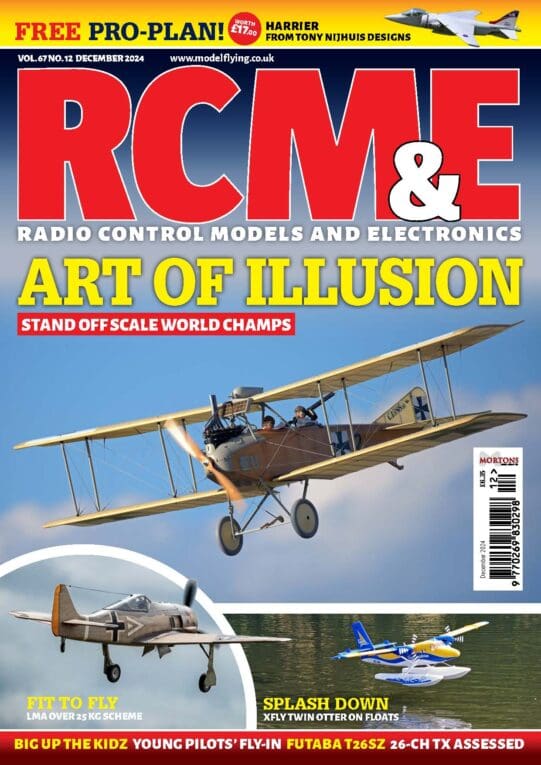Danny Fenton concludes his build of a DB Sport & Scale semi scale kit.
I used a hinging technique that I first saw Brian Taylor use. I am sure it has been around since before that, but it produces a beautifully accurate, precise and free moving hinge, with the bonus that the piano wire hinge pin can be removed to allow disassembly right up until applying the final paint.

Enjoy more RCM&E Magazine reading every month.
Click here to subscribe & save.

The hinge consists of a length of piano wire, with close fitting sections of brass tubing fitted to the wing and aileron as bearings. A length of PTFE tubing is used to ensure that the piano wire will always find its way through the aileron with little faffing when trying to find the bits of tube at either end!


The hinge points are made with sections of glass board, like circuit board but without the copper surface. Mick Reeves, amongst others, sell it. I like to use little stubs of the same brass tube as hinge re-enforcement.


The flap ribs were spaced out along the spar, with three 1.6mm glass hinge points to avoid the existing wing ribs, etc. When I first made this, it was not rigid enough. I added more diagonal braces and although not quite scale they worked a treat. The flaps are split and therefore not thick by any measure.


The flaps were a bit of a fiddle to fit and align. The other problem was they had to be fitted permanently quite early on and could not be removed to allow covering. I will have to suffer this later. You can see how I removed a good section of the rib and sheeting from the wing underside to allow this. I removed the excess after the wing was built to avoid distortion and it has worked well as the trailing edge has retained rigidity. The diagonals, though not scale, look like they could be, so I was quite pleased with that.


I mounted the aileron and flap servos the same way. Small sections of 3mm ply were used to provide a mount, with holes cut in the ribs. Now I know a lot will say, what about servo access? Well, this is where I deviate from convention as I build my servos in permanently. So far, I have never had to cut a wing open to replace one – I’m probably tempting fate now!!
The PTFE tube I use as a guide for the piano wire hinges is from www.hyperflight.co.uk and is available in many sizes. This is a worthwhile site to bookmark.
BODY TALK
The fuselage sides are made up of several different sizes of strip wood, which is all included. A word of caution here – you may get a bundle of 6mm square, but only one strip is numbered. Number them all!

Also, if you cut the number off a strip then write it on the remainder. The instructions say use 238 for example, not use 6m x 6m.
A gotcha area is the splices at the top of the cabin, these need to be really well made.

The fuel tank box is straightforward and the laser cutting in this area has obviously been revisited and is spot on. I used Titebond III for most of the ply joints.

The fuselage goes together well but you have to pay careful attention to thickness of the longerons as they change. Also, the chamfered sections are not very clear. Patience is the answer here.

The fuselage is straightforward, and good and rigid when all the bracing is added. I drew a line on the bench and pulled the sides in so that everything was straight.

When the plywood cockpit sides are added care must be taken to make sure that all the underlying sections are chamfered so this sits flat against the adjoining structure. I feathered the rear edge of the ply so that it blended into the stringers better. This is well worth the extra effort.
IDEAL ENGINE
I had been looking in the classifieds for some time and eventually I emailed Laser direct in an attempt to purchase an 80 but one wasn’t available. So, I purchased a new Saito 82 from a modeller who was in the unfortunate position that his club site had been lost and he could no longer fly. I do hope the situation improves for you, John and thanks for the engine.

Shortly after the deal was done on the Saito, Alex Pettigrew emailed me and offered me a Laser 80 for a terrific price. Thanks, Alex. But the fuel tank height and rails are set for the Saito so I will save the Laser for another model.

The parts that make up the section under the instrument coaming meant the section was not flat and it had a nasty compound curve. I sanded that compound away so that the ply had a chance to conform to the underlying structure. I used many more bands than the picture shows.


A thread indicating the centreline of the fuselage was used to ensure that the wing fairings were equidistant, and this meant some sanding of the underlying structure. But all was good in the end; it was important that the front and rear distances were equal, or wing sweep would be introduced.


I had hoped to show the covering as well in this session, but you will have to catch up with my experiments with Ceconite the next time we share a digestive.






